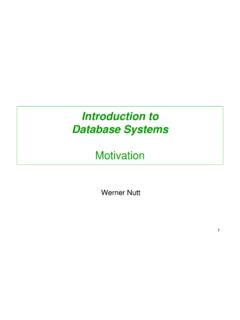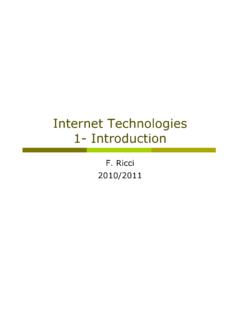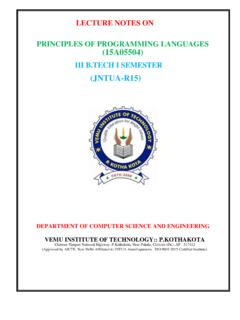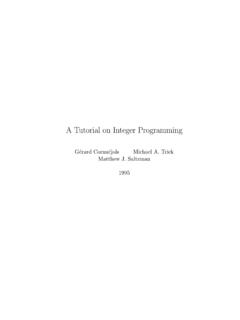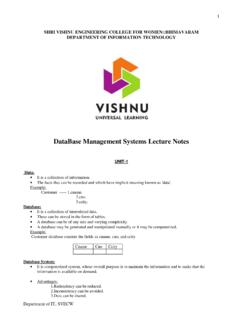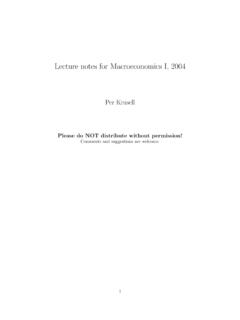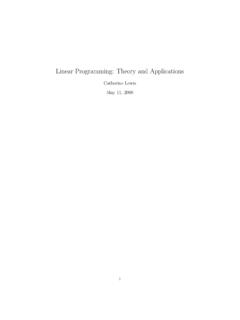Transcription of Introduction to programming - unibz
1 Unit 1 Introduction to programmingSummary Architecture of a computer programming languages Program = objects + operations First Java program Writing, compiling, and executing a program Program What is a computer? Hardware Processor Memory I/O units How does it work? Executes very simple instructions Executes them incredibly fast Must be programmed: it is the software, , the programs, that characterize what a computeractually Components of a computer12 UNIT Simplified architecture of a computerModemI/O portscontrollerDiskCentralmemoryCPUV ideocardSoundcardNetworkadapterKeyboardM ousePrinterHard diskFloppy diskCD ROM/DVDM onitorMicrophoneSpeakersOther Languages for programming a computer Machine language21 40 16 100 163 240 Assembler languageiload intRatebipush 100if_icmpgt intError High level programming languagesif (intRate > 100).
2 ProgramsThe programs characterize what a computer actually program (independently of the language in which it is written) is constituted by two fundamental parts: a representation of the information (data) relative to the domain of interest:objects a description of how to manipulate the representation in such a way as to realize the desired functionality:operationsTo write a program both aspects have to be Example: CallCenterApplication: We want to realize a program for a call-center that handles requests for telephone , a certain client requests the telephone number associated to a certain person name in a certain city,and the operator answers to the request by selecting the telephone registry of the city and searching there thetelephone number corresponding to the person name.
3 Objects: client operator telephone registry telephone numbers, person names, cities - these are just character sequences (strings) for the telephone number of a given person name in a given city, done by a of the telephone registry of the requested city, done by the of the telephone number corresponding to the requested person name on the telephone registryThe program has to represent all objects that come into play and realize all Diego CalvaneseLecture notes for Introduction to 2004/05 Introduction to Representation of the domain: objects group objects of the same type intoclasses establish therelations between the classes, , how the objects of the different classes are connected toeach other establish thepropertiesof the objects belonging to each class realize the classes, the relationships between the classes, and the properties of the classes in the selectedprogramming Class diagramTo make the classes and the relationships between the classes explicit, we can use theclass diagram: eachclassis denoted by a rectangle containing the class name; therelationsbetween classes are denoted by arrows; such arrows represent relations between classes in asimplified form, as generic usage relations.
4 The properties of classes are not :class diagram of the CallCenter (calls)uses (searches in)Class diagrams are commonly used in software design. For example, the Unified Modeling Language (UML),which is the de facto standard formalisms for software design, allows one to develop quite sophisticated Realization of operations: algorithmsUsually, we realize an operation when we need to solve a : given a person name, find the corresponding telephone number in a telephone delegate to a computer the solution of a problem, it is necessary to find an algorithm that solves the :procedure through which we obtain the solution of a problem. In other words, a sequence ofinstructions that, when executed in sequence, allow one to calculate the solution of the problem starting fromthe information provided as algorithm is characterized by: non ambiguity: the instructions must be interpretable in a unique way by whom is executing them executability: it must be possible to execute each instruction (in a finite amount of time) given theavailable resources finiteness: the execution of the algorithm must terminate in a finite amount of time for each possible setof input dataExample of an algorithm: scan the person names, one after the other as they appear in the registry, until youhave found the requested one.
5 Return the associated telephone there other algorithms to solve the same problem? Yes!Once we have found/developed an algorithm, we have tocodeit in the selected programming programming paradigmsThere are several programming paradigms, that differ in the emphasis they put on the two fundamental aspects:objects and main programming paradigms : the emphasis is on the operations intended as actions/commands/instructions that changethe state of the computation; the objects are functional to the computation; : the emphasis is on the operations intended as functions that compute results; the objects arefunctional to the computation;c Diego CalvaneseLecture notes for Introduction to 2004/054 UNIT oriented: the emphasis is on the objects, which as a whole represent the domain of interest.
6 Theoperations are functional to the orientedImperative/functionalObjectsOper ationsObjectsUsually, in a program different programming paradigms are used. Hence, programming languages providesupport (with different degrees) for the various JavaIn this course we will use theJavaprogramming is amodern,high level,object orientedprogramming language, which supports also theimperativeand thefunctionalprogramming characteristics of Java: simple platform independent (the same program can be run on Windows, Unix, MacOS, etc.) comes equipped with a very rich set of well developed libraries designed for the use on Internet based on virtual machine (see later) safe (the virtual machine forbids undesired accesses to applications running via the Internet) The first Java programimport *;public class First {public static void main(String[] args) { ("This is my first Java program.)}}
7 ");}}The statements have the following meaning: import *;request to use libraries of predefined classes/programs (in fact, is imported automatically, hence this statement can be omitted) public class First{..}definition of a class/program calledFirst public static void main(String[] args){..}definition of themainmethod (a method is the re-alization of an operation in Java) ("This is my first Java program.");statement to print a message on the video object/instance of the predefined classPrintStream printlnmethod of the classPrintStreamapplied to the "This is my first Java program."object of the classStringrepresenting the sentence to displayNote: Java iscase-sensitive, , there is a difference between lower-case and upper-case letters. ,classis different Diego CalvaneseLecture notes for Introduction to 2004/05 Introduction to Second programpublic class Second {public static void main(String[] args) { ("This is my second Java program.
8 "); (".. and it will not be my last one.");}}The sequence of two statements means that the two statements will be executed in the order in which theyappear in the Write, compile, and execute a Java of the program of the of the compiled program1. Preparation of the program textTo prepare the program text we have to write a file containing theprogram. For a Java program, the name of the file has to the name of the class defined in the program. , program can be written with any program that allows one to write a text file (editor). , NotePad,Emacs, ..Example:2. Compilation of the programThe compilation of the program is necessary to translate the program intoa sequence of commands that can be directly executed by the computer. The standard Java compiler, which ispart of the Java Standard Development Kit (Java SDK), isjavac.
9 To use it, you have to execute the compilation produces as a result a file , which contains the command that can bedirectly executed by the computer. For example:javac the Diego CalvaneseLecture notes for Introduction to 2004/056 UNIT 13. Execution of the compiled programA program can be executed only after it has been compiled, ,when we have the Java the execution of a program is done through the commandjavaClassName( ). For example, the commandjava Firstcauses the execution of the programFirst(or, more precisely, of themainmethod of the classFirst), andhence prints on the screen:This is my first Java environmentThere are applications calledprogramming environments, that allow one tocarry out the various steps of program writing, compilation, and execution in an integrated way.
10 Examplesof Java programming environments are: JavaONE, JBuilder, JCreator, ecc. The following picture shows ascreen-shot of BlueJ, a programming environment developed for teaching purposes by the Monash University,Australia, e by the University of Southern Diego CalvaneseLecture notes for Introduction to 2004/05 Introduction to From the source code to the executable program (summary)EditorJava sourcecodeCompilerClass fileMachineRunningprogramJava Note on the portability of JavaThe Java compiler does in fact not produce code that can be directly executed by the computer. Instead itproduces code that is independent of the specific computer and that is calledJava , the result of the compilation of a Java program isplatform independent. This requires the use of a specificprogram that is able to execute the bytecode: the bytecode interpreter, known asJava Virtual Machine,which is activated through the be able to execute a compiled Java program on some platform, it is sufficient to have the interpreter for theJava bytecode.


